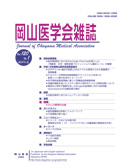

Journal of Okayama Medical Association
Published by Okayama Medical Association<Availability>
Full-text articles are available 3 years after publication.
Permalink : http://escholarship.lib.okayama-u.ac.jp/19164
Studies on the Permeability of Cell Membrane Ⅰ. Permeability Test of Cells by Supravital Staining and the Patterns of Paper-electropholesis and Paperchromatography of the Dye in the Varied pH Media
Amano, Isao
Published Date
1959-02-28
Abstract
A new method of permeability test of cell membrane by supravital staining has been introduced by Seno and Oguchi. Acording to their data the dye permeability to the cell membrane is enchanced in such media as the electric charge of the dye is reduced. But in their experiment the grade of the charge of dye has been observed by electropaperchromatography of dye in a high concentration, 1 percent. The author has found that the electrophoretic picture of dye on a paper is largely dependent upon its concentration, i. e. the size of particle which seems to increase with the reduction of the charge as is clearly seen by paperchromatography. But the test on a diluted dye solution, 0.01 percent, showed that the electrophoresis of dye goes on parallel to the charge of dye or the pH of media, where the paperchromatography gives almost constant picture by changing pH. Using Nile blue the author has observed the permeability of various cells (normal monocytes, white blood cells, bone marrow cells, Yoshida tumor cells, ascites hepatoma cells (AH-130) and L-cells at various pH's (2.2-8.6) and the following results have been obtained. In ascites hepatoma cell (AH-130) and Yoshida tumor cell the permeability to the dye is deeply influenced by the changing pH of media and the depressed permeability till around pH 4.5. The further increase of H ion concentration results in the increased damage of cell with the increased number of the deeply stained cells. L cell also showed the same tendency in the permeability to the dye. The effects of the change of pH on the permeability of the dye were marked on tumor cells and L-cells compared to those on the normal cells.
ISSN
0030-1558
NCID
AN00032489
